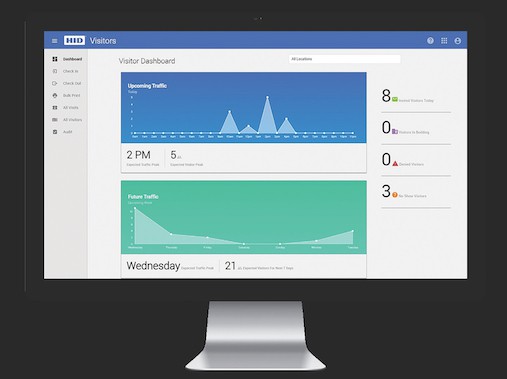By Nitin Parihar
From the February 2024 Issue
Enterprise cloud computing is a boon to organizations that want to manage important processes through business applications rather than their own infrastructure. Taking this route eliminates significant investments in data centers, bandwidth, and servers. As adoption has grown, organizations have learned they can trust in the security of their Software-as-a-Service (SaaS) cloud services provider and proven industry best practices that now meet or exceed what they had come to expect with on-premises solutions.
Facility managers who work with these SaaS providers can also more easily adopt new visitor-management capabilities. One of the most popular is multi-layered security solutions that incorporate duress alerting to protect workers from growing incidents of violence, especially in the hospital setting.

Baseline Benefits Of SaaS Visitor Management Solutions
One of the first benefits of SaaS visitor management solutions is that they meet an organization’s safety and compliance requirements without the need for expensive and complicated in-house systems. Besides reducing solution acquisition costs and infrastructure investments, the SaaS approach also eliminates the risk of downtime or infrastructure obsolescence. SaaS solutions can be updated and re-configured when needed, without requiring any additional any IT department resources. Disruptions and downtime are further avoided through continuous software updating.
Other benefits of SaaS visitor-management solutions include removing the risk of exposing critical information, while delivering a number of operational advantages. For instance, users can easily share visitor traffic reports wherever they are needed to meet compliance reporting requirements. This is one of a visitor-management system’s most important functions and, with a SaaS solution, the reporting information is always secure and available even in the aftermath of a disaster or technical malfunctions.
Also valuable is the scalability of SaaS visitor-management solutions. A facility manager who chooses a long-term solution provider will be able to adapt their implementation to meet evolving requirements. They also will be able to integrate their solution with screening services and access and IT systems such as Visual Compliance, Ccure and Lenel to Azure AD, OKTA, AD Outlook and Google Workspace, among others. This ability to integrate the SaaS visitor-management solution with existing systems also delivers benefit to visitors; when their information is already available, they don’t need to fill out forms again, and whatever calendar option they use, it will always be supported.
In addition to these baseline benefits, today’s SaaS visitor management solutions open the door to the latest innovations, both today and in the future. One of the best examples is how SaaS solutions are supporting multi-layered workplace safety and security initiatives.
Protecting Workers From Danger
SaaS visitor-management solutions provide one of the best convergence points for workplace safety technologies. Not only do they integrate with and support other services, they also improve workplace safety by combining identity, access and visitor management software with ID badges for staff and visitors, and duress-alerting capabilities for these ID badges.
These are important new capabilities in a world where U.S. state legislatures are closely scrutinizing workplace violence prevention. Some, like California, have already instituted regulations in this area. For example, California Code of Regulations, Title 8, Section 3342, requires healthcare employers to implement such measures as incident logs and special record keeping, in addition to generating a workplace violence prevention plan.
These kinds of multi-layered security requirements can be met with a well-implemented visitor management solution that enables administrators to see and share information ranging active shooter incidents and subsequent lockdown procedures to emergency responses to ensure that all people have been accounted for. These solutions can also be used for duress alerting via employee ID badges, simply by integrating them with an organization’s HR, IT and access control systems.

To do this, organizations first issue badge holders to their employees that incorporate special buttons that can be used to discreetly and silently call for help. Enabling employees to secretly signal in this way reduces the risk of an attacker escalating the violence before help can arrive. On a badge holder, these buttons are placed on the reverse side of the badge holder. On a key fob they are located on the sides. An alert is sent to the cloud through connected gateways that are installed throughout the campus or building to ensure that badge holders are always within range and can trigger one of many possible policy-based responses.
This type of solution can also be extended to bring situational awareness beyond employees and across the entire building or campus to create a complete Real Time Location Service (RTLS) solution for a hospital or other healthcare environment. For example, patients can be given devices that are worn around the wrist like a watch, that streamline the patient-management process from admissions through discharge while saving time and money, cutting human error, and creating a safer and more satisfying patient experience.
Best Practices For Implementation
Building Security: Facing Converging Cyber-Physical Risks
Open-source intelligence and digital investigations can help organizations more accurately predict major threats to their operations. Read more…
Visitor management solutions have come a long way from rudimentary front desk apps or tablet check-in tools, many of which provide no way to improve security or support compliance requirements. Instead, the latest solutions not only improve security and compliance but also address safety and user convenience needs while providing significantly more capabilities, from managing data to integrating with an organization’s other internal systems, to providing alerts and reports, watchlist cross-referencing, preregistration, emergency alerting and broadcasting messages.
The easiest way to implementing these capabilities is through a SaaS provider with a proven track record for not only delivering solutions but integrating them with current HR, IT and access control systems. This type of supplier will also provide invaluable assistance with adhering to key regulatory and other compliance requirements, while simplifying deployment, reducing acquisition costs, future-proofing investments through the scalability to support new requirements, and minimizing downtime and the risk of obsolescence.
 Parihar is Director of Product Management at HID. He brings over 12 years of experience in the identity and access management spaces. For the last six years, Parihar has provided product management and product marketing leadership for HID Visitor Manager and PIAM products. Prior to joining HID, he led a team managing identity access management (IAM) products at Thomson Reuters.
Parihar is Director of Product Management at HID. He brings over 12 years of experience in the identity and access management spaces. For the last six years, Parihar has provided product management and product marketing leadership for HID Visitor Manager and PIAM products. Prior to joining HID, he led a team managing identity access management (IAM) products at Thomson Reuters.
Do you have a comment? Share your thoughts in the Comments section below, or send an e-mail to the Editor at jen@groupc.com.

















 Building Security: Facing Converging Cyber-Physical Risks
Building Security: Facing Converging Cyber-Physical Risks
![[VIDEO] Collect Asset Data at the Speed of Walking a Building](https://facilityexecutive.com/wp-content/uploads/2024/02/maxresdefault-324x160.jpg)